- Lowe’s (LOW) has posted incredible gains in 2021
- House price acceleration encourages people to spend on their home
- COVID and working from home also boosts spending on home improvement
- Shares look somewhat expensive
- Consensus outlooks for LOW suggest a muted positive outlook
Lowe’s (NYSE:LOW) shares have returned 57.2% for the YTD and 68.7% over the past 12 months, beating the Home Improvement Retail Industry (total returns of 54.4% and 57.1% for these two periods, respectively).
These remarkable gains for the industry and for the Mooresville, North Carolina-based home improvement retail chain have occurred thanks to an extremely positive confluence of events for home improvement.
First, low interest rates have continued to spur the housing market to ever-higher levels, making people feel as though any investment in their homes is worthwhile. Second, the work-from-home trend got a huge boost from COVID-related shutdowns, and continues to grow as workers push their employers to support remote work going forward. More time spent at home encourages improvements to facilitate new working and living situations.
For a deep dive into home improvement trends, see this paper from the Joint Center for Housing Studies at Harvard University.
While global supply chain slowdowns have the potential to hamper Lowe’s earnings, the company has been proactive in getting out ahead of this issue.
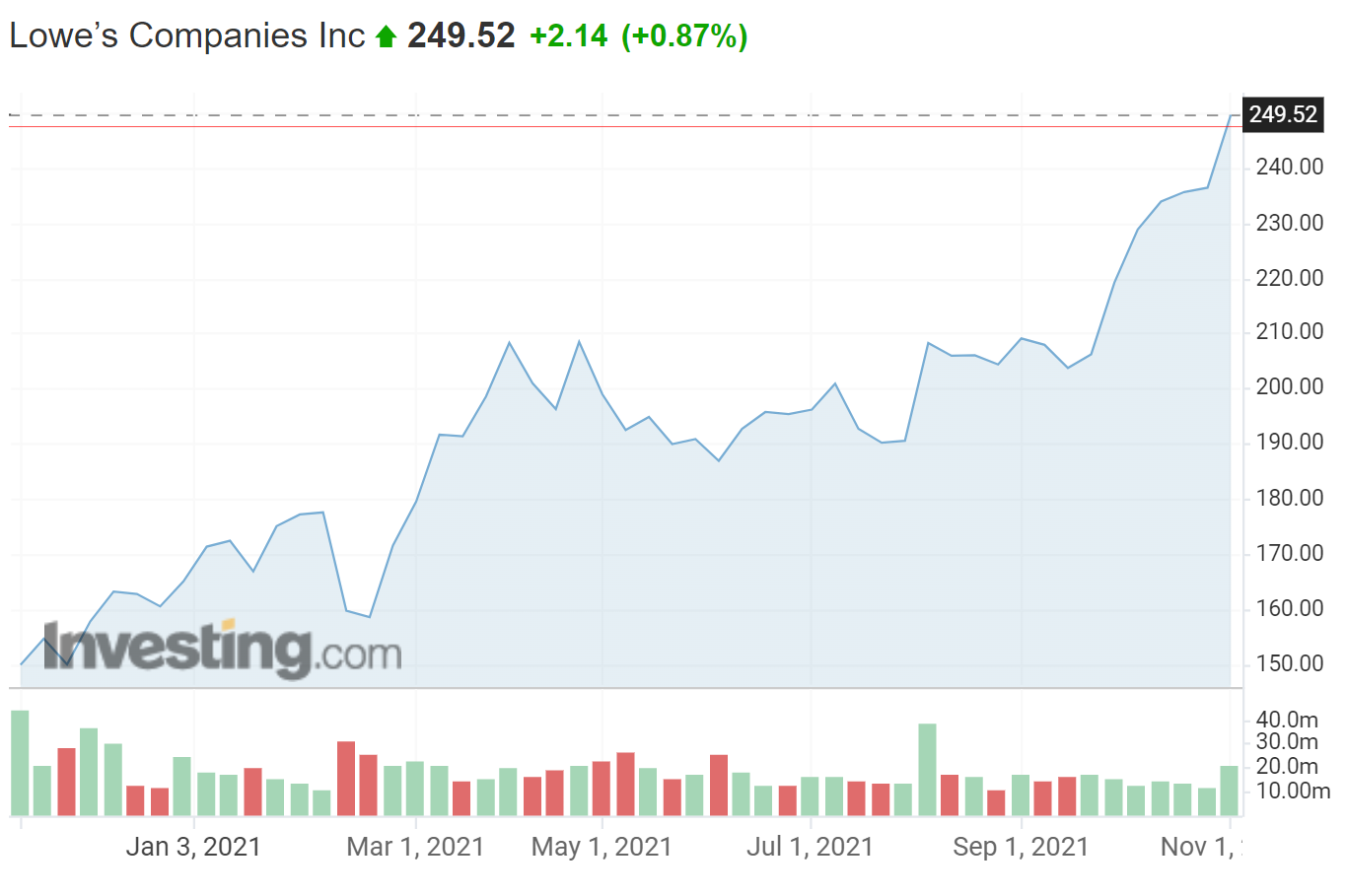
Source: Investing.com
Lowe’s reported Q3 earnings on Nov. 17, beating the consensus EPS by 15.9%. The company has beaten expected EPS by healthy margins over the past year. While there has been some concern that home spending would slow as the economy re-opened, this has not occurred yet. The Q3 results were dramatically above Q3 EPS from last year.

Source: E-Trade. Green (red) values are amount by which reported quarterly EPS exceeded (missed) consensus expected EPS.
The consensus outlook for EPS growth over the next 3-5 years is 22.8% per year. The current dividend yield is quite low, 1.28%, but the dividend growth rate is high. The 3-, 5-, and 10-year annualized dividend growth rates are 16.3%, 17.3%, and 18.8%, respectively. The payout ratio is a low 26.7%.
LOW has a consensus forward P/E of 21.2 and trailing P/E of 25.5. These values are fairly high as compared to historical values, but not especially so.
I last analyzed LOW on June 3, 2021 and assigned a bullish rating. At that time, LOW had fallen 9.2% from the YTD high close set on May 10. Since that post, LOW shares have gained 31.33% (not including dividends) as compared to 12.1% for the S&P 500 over the same period.
Along with considering the fundamentals, I rely on two forms of consensus outlooks in forming my opinion on a stock. The first is the well-known Wall Street analyst consensus rating and price target. The second is the consensus price return outlook implied by options prices. The price of an option on a stock reflects the market’s consensus estimate of the probability that the shares will rise above (call option) or fall below (put option) a specific level (the strike price) between now and when the option expires.
By analysing call and put options at a range of strike prices, all with the same expiration date, it is possible to calculate a probabilistic forecast for price returns that reconciles the options prices. This is referred to as the market-implied outlook.
When I examined LOW in June, the Wall Street analyst consensus was bullish, with a 12-month price target that was about 20% above the share price at that time. The market-implied outlook was slightly bearish. In considering the fundamentals, and balancing the strongly bullish Wall Street consensus and the slightly bearish market-implied outlook, I assigned a bullish rating overall.
With the 30%+ gain in LOW for the (roughly) 5 months since my analysis in June, along with the recently reported Q3 results, I have updated the market-implied outlook for LOW for comparison with the Wall Street consensus outlook.
Wall Street Consensus Outlook for LOW
E-Trade calculates the Wall Street consensus by combining the views of 14 ranked analysts who have published ratings and price targets over the past 90 days. The consensus rating is bullish and the consensus price target is 10.44% above the most recent closing price. The spread in the price targets is quite low.
In my June analysis, the consensus 12-month price target from E-Trade was 20% above the share price at that time. Analysts have raised their price targets as the share price has gone up in recent months, but the estimated 12-month upside is considerably lower because of the substantial price appreciation.

Source: E-Trade
Investing.com’s version of the Wall Street consensus is calculated using 31 analysts. The consensus rating is bullish and the consensus 12-month price target is 7.24% above the current share price.
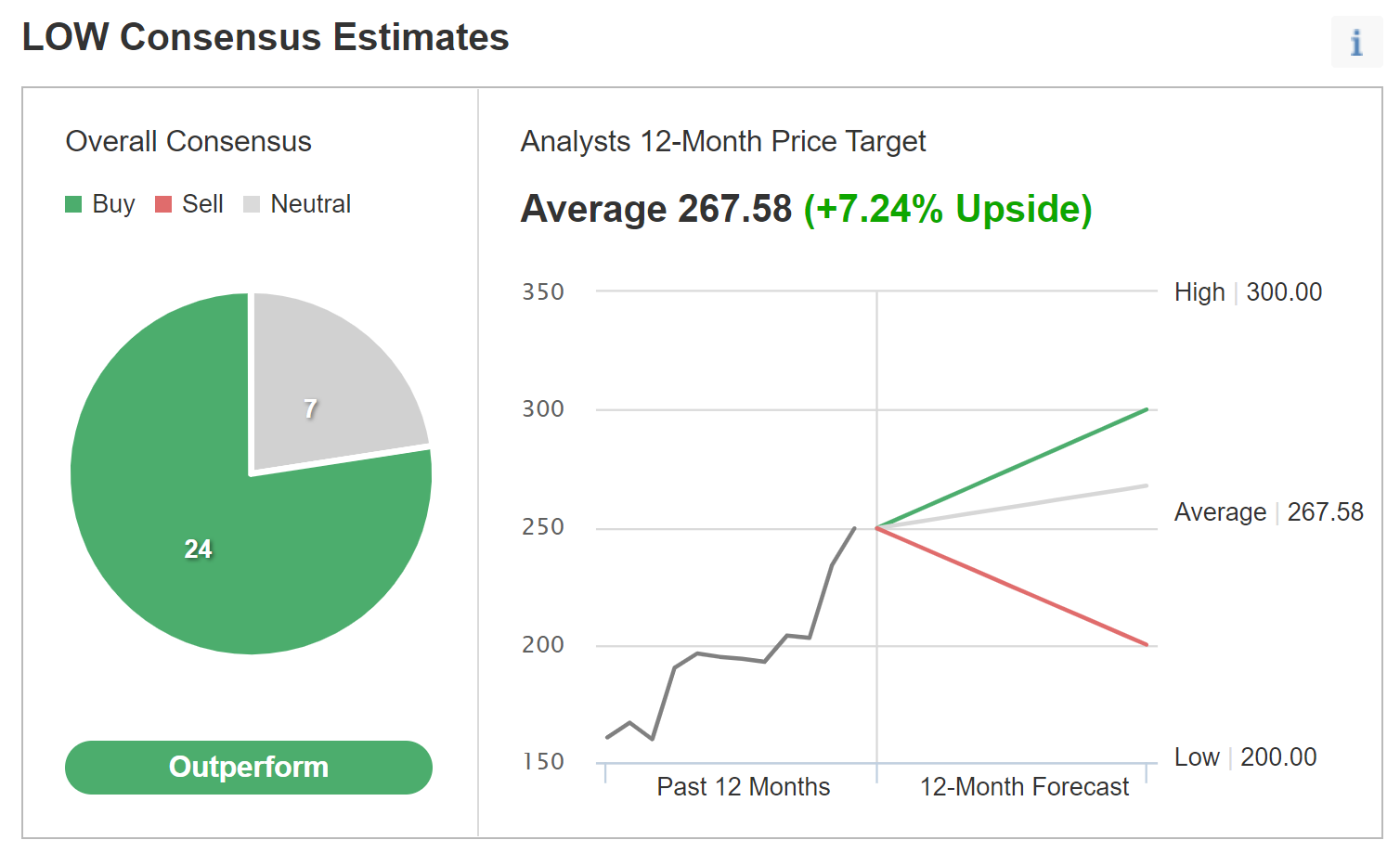
Source: Investing.com
Wall Street analysts are bullish on LOW, although the potential for gains is modest as compared to the trailing annualized returns. The 5- and 10-year annualized returns for LOW are 30.3% and 27.5%, respectively. The share price has risen sufficiently that there is limited room to run.
Market-Implied Outlook for LOW
I have calculated the market-implied outlook for LOW for the 2-month period from now until Jan. 21, 2022 using options that expire on that date. I have also generated the 3.8-month and 6.9-month outlooks using options that expire on Mar. 18, 2022 and June 17, 2022, respectively.
The standard presentation of the market-implied outlook is in the form of a probability distribution of price return, with probability on the vertical axis and return on the horizontal.
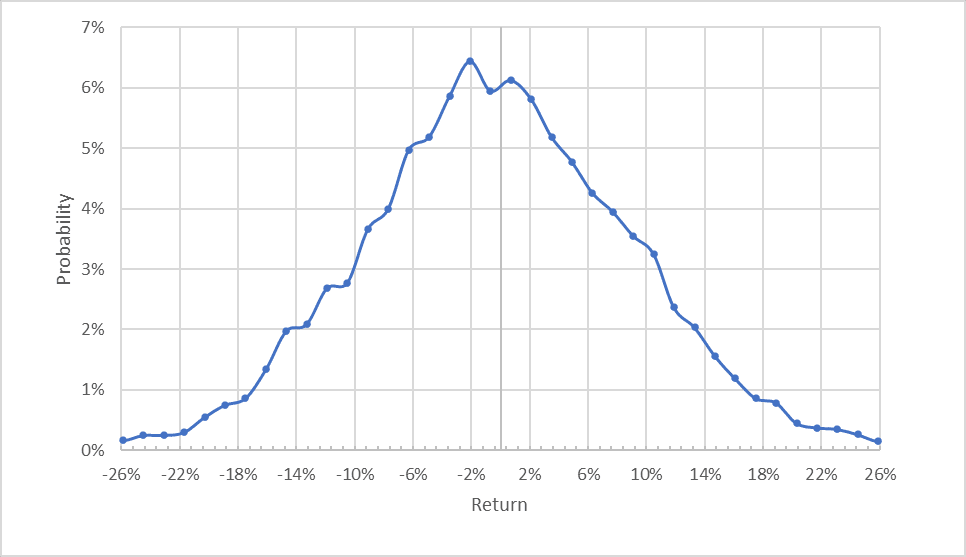
Source: Author’s calculations using options quotes from E-Trade
The market-implied outlook indicates comparable probabilities of positive and negative returns, but the maximum probabilities are tilted towards negative returns. The peak probability corresponds to a price return of -2%. The annualized volatility calculated from this outlook is 27.5%, slightly lower than the annualized volatility outlook that I calculated in June (29%).
To make it easier to directly compare the probabilities of positive and negative returns, I rotate the negative side of the distribution about the vertical axis (see chart below).
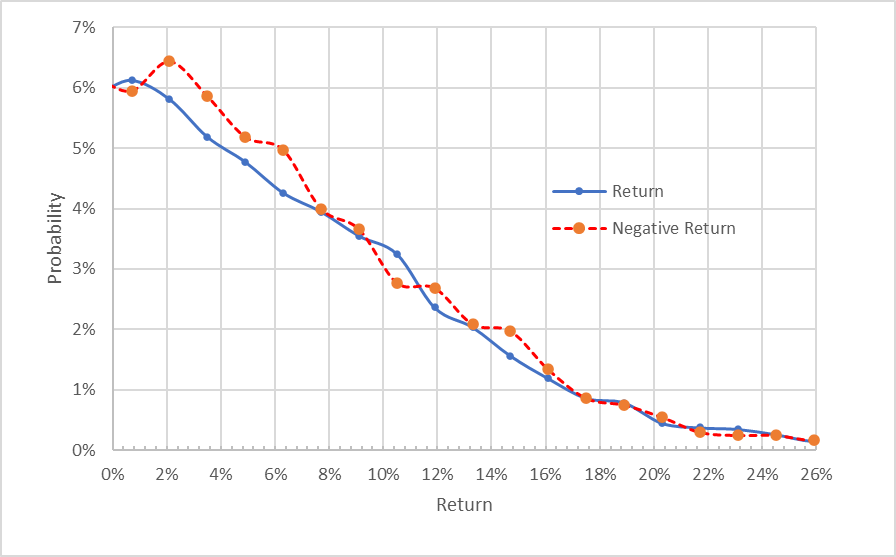
Source: Author’s calculations using options quotes from E-Trade. The negative return side of the distribution has been rotated about the vertical axis.
With the exception of the small peak in probability at -2% that raises the probabilities of small-magnitude negative returns, the probabilities of positive and negative returns of the same magnitude are very close to one another (the red dashed line is close to the solid blue line).
Theory suggests that the market-implied outlook will tend to have a negative bias because investors, in aggregate, are risk averse and pay more than fair value for risk protection (put options). In this event, the probabilities of negative returns that are calculated to be consistent with the options prices, will be biased to suggest too high a probability of loss. In light of the potential negative bias, I interpret this market-implied outlook for LOW to be slightly bullish.
The market-implied outlook for the 3.8-month period to Mar. 18, 2022 is consistent with the shorter-term outlook. The maximum probability corresponds to a price return of -2.9%. The probabilities of positive and negative returns are very close to one another, although there is a small range of outcomes with slightly elevated probabilities of negative returns. In light of the probable negative bias in the market-implied outlook, I interpret this as a slightly bullish view from the options market. The annualized volatility calculated from this distribution is 30%.
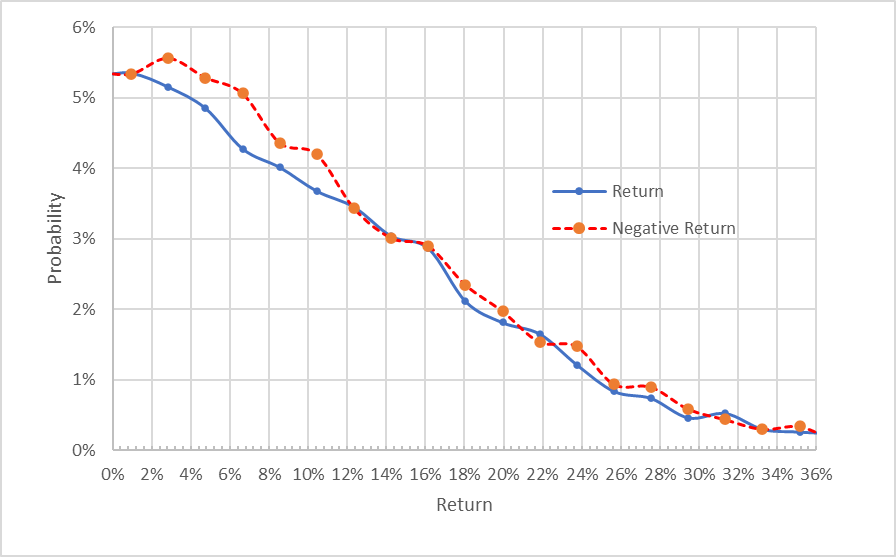
Source: Author’s calculations using options quotes from E-Trade. The negative return side of the distribution has been rotated about the vertical axis.
The market-implied outlook to June of 2022 is an extension of the view to January and March. The peak probability corresponds to a return of -3.9% for this 6.8-month period. The annualized volatility calculated from this distribution is 30%.
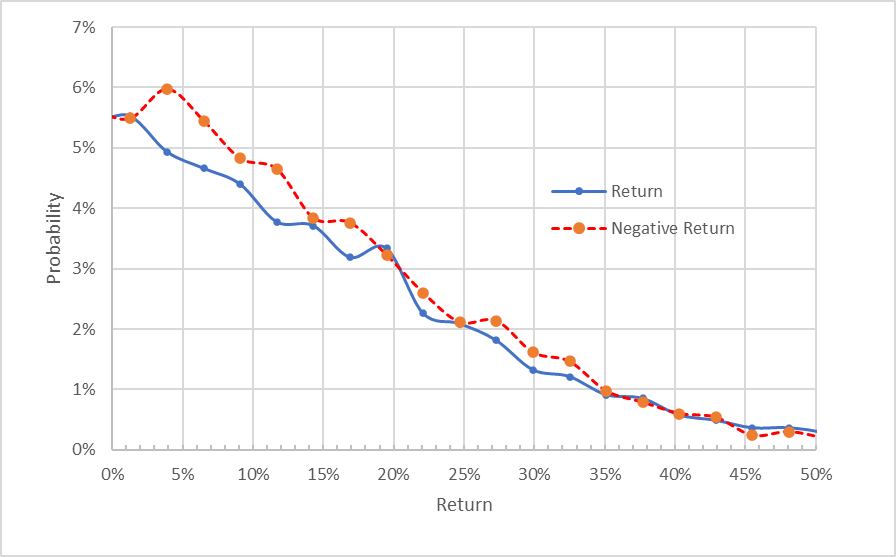
Source: Author’s calculations using options quotes from E-Trade. The negative return side of the distribution has been rotated about the vertical axis.
The market-implied outlooks calculated for the next 2-, 3.8-, and 6.8-month periods show probabilities of positive and negative price returns that are very close, although there are slightly elevated probabilities of smaller-magnitude returns. The expected volatility is about 30%. These results suggest a slightly bullish outlook for LOW.
Summary
LOW has rallied substantially over the past year for the outlined reasons and the current valuation is somewhat high. The Wall Street analyst consensus 12-month price target is about 8.8% above the current share price (averaging to the two consensus numbers), for an expected total return of 10.1%.
The Wall Street consensus rating is bullish, but a 10% expected return on a stock with 30% volatility is not terribly attractive. The market-implied outlooks to the middle of next year are slightly bullish.
While the price appreciation over the past year reduces the upside potential, I am maintaining my bullish view on LOW.
